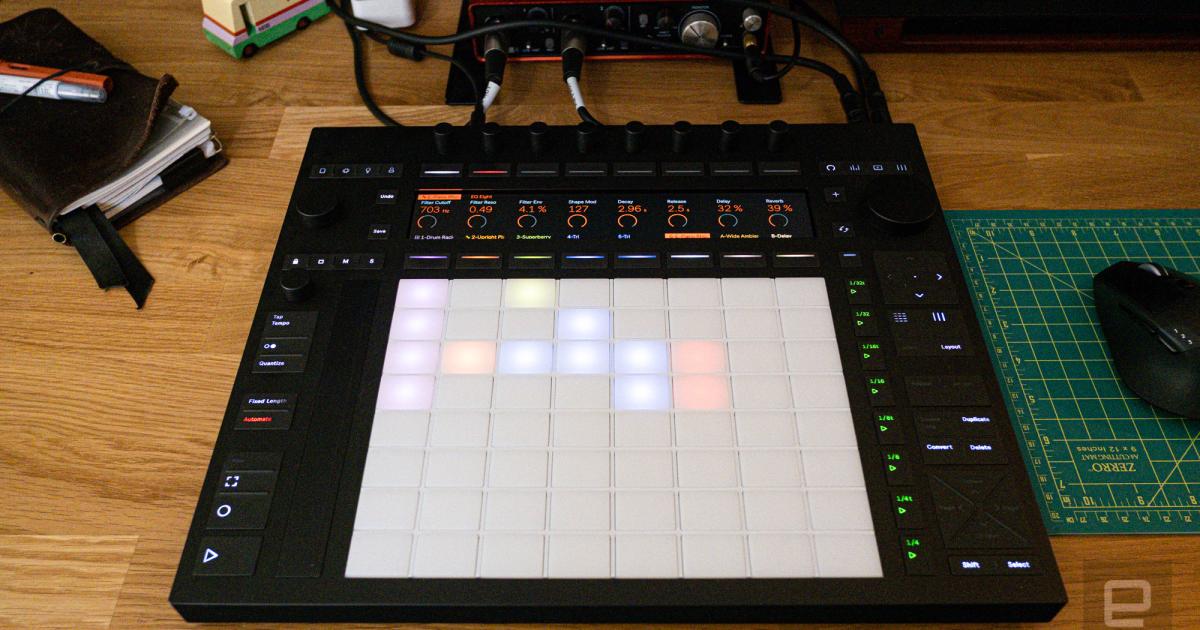Global Courant 2023-05-23 13:11:18
Rumors have been swirling around Ableton’s Push 3 for years. Arguably the best hardware controller for one of (if not the) most popular DAWs (digital audio workstation), the Push 2, was released in 2015. And nearly eight years later it’s still head and shoulders above much of the competition. But there are some modern amenities that it’s lacking. And Native Instruments changed the game in 2020 when it released the Machine+, a controller for its desktop suite that could also function as a standalone music production box thanks to an Intel Atom CPU and 4GB of RAM.
Considering the long lead times required for product development, it’s safe to assume that Ableton was already hard at work on its new controller when Maschine+ was announced. But I’d also venture to guess that the company watched the reaction to Native Instruments’ box closely and tweaked its plans accordingly.
The result is the Ableton Push – not Push 3, not Push+ – just Push. And it makes a hell of a first impression. It comes in two configurations, a basic controller for $999 and with a processor for $1999. With a processor it can function as a fully standalone instrument, like the Maschine+. But it still also offers tight integration with Ableton Live 11 when connected to a computer. It has 64 MPE enabled pads, that pair perfectly with Live’s latest updates. It has a built-in battery for truly untethered creation. And, in a pleasant surprise, even if you stick with the controller only variant to start, you’ll be able to upgrade it with a DIY kit later this year for full standalone operation.
Photo by Terrence O’Brien / Engadget
But let’s start with the hardware. Physically the new Push and the Push 2 are very similar. They’re both hulking black slabs that seem like they were ripped out of the control panel of an alien spaceship. The screen appears to be exactly the same. And that’s not a bad thing. It’s a large, reasonably high resolution LCD with excellent viewing angles. It refreshes fast enough that you actually watch your MIDI notes scroll by in real time as you record them. The UI itself is simple and intuitive but attractive. There’s no unnecessary graphics or anything, just clean lines and text.
The knobs, buttons and pads all feel great. One of the new additions to the controls is a large jog wheel to the right of the screen that is a delight. It’s reminiscent of the one on Polyend’s Tracker, but more noticeable detents. (Another fun feature Push borrows from Tracker is auto generated project names, which comes in handy.) And the pads. Well. They’re the first I’ve encountered that truly give Akai’s a run for their money. I think I still have a slight preference for the feel of an MPC’s larger pads but, those aren’t MPE capable so, Ableton wins? My only complaint about the hardware really is that the pads might be too sensitive. But that can easily be fixed by going into the settings. Which you should probably do anyway to tweak the responsiveness to your liking since MPE can be fickle and unforgiving at times.
Photo by Terrence O’Brien / Engadget
Around back you’ll notice you’ll find a bunch of new connections too. There’s USB-C for connecting to a computer to control Live, a 12v DC connector, and two jacks for connecting sustain pedals just like on a Push 2. But those pedal jacks can also send CV now, so you can control modular gear. There’s also a USB-A port for connecting class compliant MIDI controllers, so if pads aren’t your thing you can connect a keyboard, or play one instrument with the keyboard while knocking out drum tracks on the Push directly. You’ll also find ⅛” MIDI in and out ports.
More importantly, there are two audio ins and two audio outs, plus a headphone jack and two ADAT jacks for connecting to other audio gear. See, the new Push – even without a processor in it – is also an audio interface. Granted it only has ¼” jacks (switchable between balanced and unbalanced), so not ideal if you’re recording vocals and need an XLR jack with phantom power. But if you’ve got another audio interface already with ADAT you can connect it to the Push and then suddenly you’ve got eight or 12 or however many inputs to work with. It is truly capable of being the centerpiece of a recording studio now.
Photo by Terrence O’Brien / Engadget
If you opt for the Push with a processor you’ll find an 11th Core i3 inside, with 8GB of RAM and a 256GB hard drive. That might not sound like much, but it’s plenty of power to handle most audio processing, especially without the overhead of trying to handle a windowing system and security software and those 16 Firefox tabs you haven’t closed in about three months. In fact, I noticed far less latency working with live audio on the Push directly than I do on my XPS 15 with a 8th gen Core i7 CPU, 32GB of RAM and a second generation Focusrite Scarlett interface. If you’re concerned about your $2,000 MIDI controller / groovebox becoming obsolete though, Ableton says it expects to make processor upgrades available in the future.
That Intel NUC Compute Element does chew through the battery pretty quickly, though. Ableton estimates that Push can get two to two-and-a-half hours out of the battery, which lines up with my anecdotal experience so far. The Push is kinda big and heavy at 8.7 pounds, I wouldn’t exactly call it portable. But it’s actually been great to sit down on my couch at night, after the kids go to bed and chip away at this review without an elaborate setup or being tied to an outlet.
Photo by Terrence O’Brien / Engadget
Hardware is all well and good, but what is really going to make or break the experience here is the software and, well, so far so good. A few intriguing things to note at the top, the Push is running Linux. Which means that, technically, Ableton Live 11 has been ported to Linux. I don’t think you should get your hopes up about an official port being made available for that Mint box you’ve been building, though. I’ve also been told that VST support on Push is technically possible, although obviously that would require getting developers on board and converting their plugins.
There is one way of getting third party instruments on Push though – Max for Live, a development platform inside the DAW. Support for Max is huge as it can really open the possibilities of the Push as a standalone instrument. Ableton even recently released a pack of building blocks and tutorials to encourage people to build their own Max for Live devices. And there’s companies like Force that build incredible commercial products that run on Max. Support right now can be spotty since the controls need to be properly mapped for Push. And even some of Ableton’s own Max devices like the Inspired by Nature series don’t work properly at the moment.
Photo by Terrence O’Brien / Engadget
But don’t worry, Ableton’s built-in devices are excellent. And while I might be sad not having access to my favorite softsynth in standalone mode, you can easily build a complete and highly polished track using nothing but the default Live instruments and effects. But if you need more variety, you can install Ableton sound packs directly over wifi. You can also drag over your own sample library using the Continuity feature in Live 11. You’ll see Push showup in the sidebar when connected to the same wifi network. Although, oddly, you can’t transfer over USB.
In addition to dragging over samples you can pull over presets, collections and favorites. I highly recommend, by the way, that you use the Collections in Ableton to organize your goto sounds, effects, et cetera. While the jog wheel is certainly an improvement, it can still be a bit of a slog navigating through long lists of presets and samples. Organization – not my strong suit – is clearly key to getting the most out of Push as a standalone instrument.
One incredible feature of continuity though, is being able to connect to your Push and pull a project you started in standalone mode into the desktop app for final arrangement. Which is kind of essentially because, while Push seems great for jamming, live performance and sketching out ideas, you can’t do fine tuned arrangement editing or mix down to audio.
Photo by Terrence O’Brien / Engadget
Obviously the price is going to be an issue, though. The standalone configuration costs $1,999, while the controller only variant will set you back $999. The DIY upgrade kit is expected to ship later this year for $1,049. That’s a lot for a MIDI controller, even one as nice as this. And while I’m fairly certain there aren’t any DAWs in a box as powerful as what Ableton has put together, they’re also not nearly as expensive. Even Maschine+ is only $1,199.
I’ve only had Push for about a week and am still coming to grips with the workflow. So this is really more of an extended hands-on than a full review. While Ableton is my DAW of choice and I own a Push 1, the differences are significant. Plus there are still some software kinks to iron out. I’ve encountered a handful of bugs, especially when trying to edit MIDI notes in the piano roll. And once the entire unit froze up on me. But the Push is currently running prerelease firmware and requires a beta version of Live 11 to take advantage of Continuity. I plan to continue testing Push and revisit it for a long-term review.




